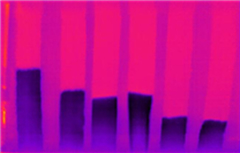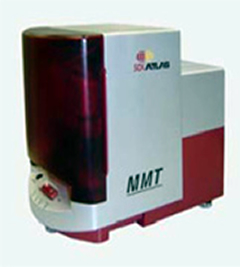Liquid Moisture Management
Comfort tests to determine fabric performance with respect to management of liquid moisture, as in the case of sweating skin, are conducted in a standard atmosphere laboratory (70 ± 2°F and 65% RH).
Vertical Wicking

The rate of water transport is measured according to a vertical strip wicking test. One end of a fabric strip is secured vertically while the opposite end dangles in a dish containing distilled water. The height to which the water was transported along the strip is measured at intervals of 1, 5, and 10 minutes, and reported in centimeters (cm). Higher wicking values show greater capability for transporting liquid water. Thermal imaging is used to monitor moisture transport when wicking cannot be easily detected with the naked eye.
Gravimetric Absorbency Testing System (GATS)

This test indicates the lateral wicking ability of a fabric, or the ability of the material to take-up liquid spontaneously in the direction perpendicular to its plane. Often this phenomenon is referred to as demand wettability. Demand wettability is measured by the amount of water drawn from a water filled reservoir through a tube connected to a porous, sintered glass test plate designed to mimic sweating skin. The test plate self adjusts to maintain a zero hydrostatic pressure differential relative to the water reservoir; water is drawn into the test fabric via capillary action.
Absorption measurements include the following:
- Wd – dry weight of the conditioned sample specimen, grams
- Ww – wet weight of the sample specimen at the end of the test, grams
- V – amount of water passed from the reservoir during 1000 seconds, grams
- T – time, minutes. This is the point where the extrapolated absorption and evaporation areas of the curve intersect.
Absorption parameters calculated from the above measurements include the following:
- C – absorbent capacity, grams, the amount of water contained in the sample at the end of the test. Higher values indicate more moisture is absorbed.
- Q – absorbency rate, g/min, the rapid rate of fluid loss, indicated by the high slope in the initial phase of the test. Higher values are generally desirable – meaning moisture is absorbed faster.
Evaporation parameters calculated from the above measurements include the following:
- Ep – percent evaporation, indicating the ratio of evaporated moisture to moisture absorbed. Higher values are generally desirable – meaning more moisture is evaporated.
Moisture Management Tester

The Moisture Management Tester (MMT) measures, evaluates and classifies liquid management properties of fabrics per AATCC Test Method 195. The MMT evaluates absorption properties by measuring changes in electrical conductivity. A specimen is horizontally placed between an upper and lower sensor having concentric pins. A predetermined amount of a prepared test solution is dropped on the center of the upper facing surface (skin side) of the test specimen. As the solution is transported throughout the specimen, changes in electrical resistance are measured and recorded. Resistance output is then used to calculate moisture content. Results are used to grade the fabric using predetermined indices.